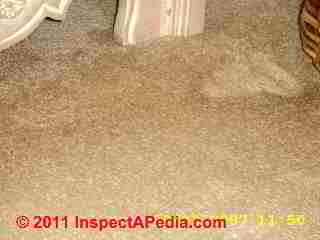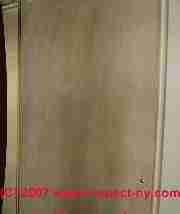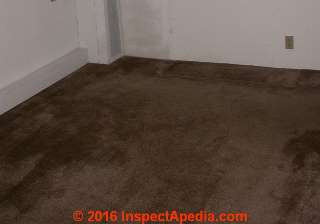 Carpet Stain Test Procedure
Carpet Stain Test Procedure
Do you need to test the stain? If so, start here
- POST a QUESTION or COMMENT about testing procedures for diagnosing indoor stains on carpets, rugs, or upholstered couches, chairs, furnishings
How to decide if you need a tests to identify carpet or furnishing stains, and how to proceed if you do.
We explain why most carpet stains do not need to be tested - save your money to spend on cleanup or on a new carpet.
This article series describes methods for diagnostic testing of interior stains on carpets, rugs and on other surfaces in buildings. While we can usually identify the key components of a building stain by appearance, location, surroundings, & apparent cause, some stains & marks in or on building materials & surfaces can be ambiguous and some may represent harmful or even dangerous contaminants or unsafe building conditions.
InspectAPedia tolerates no conflicts of interest. We have no relationship with advertisers, products, or services discussed at this website.
Diagnostic Tests for Mold, Pet Stains, Soot & Other Carpet Stains
 Before testing an indoor stain for identification or hazards
Before testing an indoor stain for identification or hazards
- Rule out natural color variations:
Some apparent building stains may not be an actual stain at all but rather the original color or color variations in natural materials such as the birch plywood door shown at left.
Sometimes what you think is a new building stain is actually a color variation that has been in place for some time, but was not previously attended. - Identify thermal tracking stains from normal house dust
See CARPET AIR LEAK STAINS at WALLS - if you can identify the stains from these examples, testing is not necessary. - Review the carpet stain patterns, color, location, history, etc.
Review the diagnostic carpet stain example photos found
at CARPET STAIN DIAGNOSIS - home, where we use simple visual examination to identify the type of carpet or rug stain and its probable cause.
There we also give links to PDF downloads of carpet and rug cleaning procedures. - Moldy carpet test? Do you need to test or identify the mold?
Usually not; knowing the mold genera/species won't change what actions are needed.
See details at CARPET MOLD / ODOR TESTS
While particle identification would certainly be technically interesting (and a forensic lab fee may be as little as $50 or $100), even if a significant component of the dark carpet stain particles are identified as soot, we should not assume that the source you found is the only or most important one - not before performing a more thorough inspection of the building and its mechanical systems.
In other words, while we love particle testing and identification (I operate a forensic microscopy particle identification lab), you should not use a test or two as a substitute for a thoughtful inspection of the building.
What to Try Now
If you are convinced that lab testing is not really necessary, you might prefer to spend your money and energy on
I'm not sure just what process the local carpet cleaner used, but I agree that if it was ineffective, you need to try something else. Sometimes we find that a stain that is very resistant to one approach is removed easily by another.
A client spent a large effort using solvents to try to remove some brown goop that we thought was tile mastic. When she tried using plain water the goop came up easily - it was water soluble but was resistant to other solvents.
Cleaning of the carpeting: you may need to hire a carpet cleaning service that uses steam or even a rug shampoo and water extraction procedure. I'd avoid really wet carpet shampooing or any process that soaks or wets wall to wall carpeting if possible.
Discuss the suspected type of stain and what was tried before with your new carpet cleaner in deciding what cleaning process is necessary.
Inspecting all other gas-burning appliances in the building to be sure that they are operating safely and properly
I'm not sure what portable air cleaner model you have been using but our experience is that while a portable air cleaner will remove some indoor air particles, there is no evidence that those devices move and process enough air to remove high levels of airborne particles throughout a building.
However, if your home has central air heating and/or air conditioning, check and maintain your air filters.
See AIR FILTERS for HVAC SYSTEMS.
If the sooting is from a problem source and not simply the common room perimeter carpet staining that occurs in buildings due to air movement, cooler wall/floor junctions and normal house dust deposition, and if you clean the carpets and fix the soot or debris sources you can find by inspection, there's a good chance that the problem will not recur.
If unusual carpet sooting stains recur, then further inspection and perhaps even testing would be appropriate.
Also see CARPET CONTAMINATION TEST PROCEDURE
How to Use Particle Identification to Diagnose the Source of Dust, Dirt, Soot, or Debris Stains
It is often possible to collect samples of suspect dust or debris for microscopic analysis in order to suggest a source or type of source of indoor stains.
It is essential that you select a forensic laboratory whose staff includes people experienced and trained in the identification of a wide range of indoor particles. A lab specializing in mold or allergen identification, for example, may not consider much less apply methods used to identify oil burner soot, common components of ordinary house dust, mite fecals, pet dander, human skin cells, fabric fibers, or other indoor particles which, if properly identified along with a statement of relative frequency in the sample, may be diagnostic.
Collect Indoor Dust, Debris, or Stain Particles for Microscopic Lab Analysis
OK so you've decided you want to collect test samples of stuff: stains, dirt, debris, suspected mold, perhaps to try to identify the source of mysterious particles or soot.
Hard Surface Stains: How to Collect Samples of Stains, Dust, or Debris on Hard Surfaces
For particles or stains found on hard surfaces indoors such as walls, ceilings, or un-upholstered furniture, often a simple adhesive tape sample will perform best. Furthermore, this sampling procedure is itself diagnostic, since if the adhesive tape is unable to lift and collect any particles from the surface, that also tells us something about the type of staining present.
But remember that even an apparently "clear" tape sample (when viewed by the naked eye) may contain important diagnostic particles which will be quite evident when viewed as a properly prepared microscopic sample and at proper magnification and lighting in a forensic microscope.
See DUST / MOLD TEST KIT INSTRUCTIONS for a surface sampling procedure using adhesive tape. You can use this sampling method to collect surface particles for submission to any qualified forensic laboratory not just ours.
Carpet or Furniture Stains: How to Collect Samples of Stains, Dust, or Debris from Soft Surfaces like Carpets or Furniture
 Details about particle collection using adhesive tape or vacuum cassette test methods for carpet debris or stain or suspected-mold contamination are detailed
Details about particle collection using adhesive tape or vacuum cassette test methods for carpet debris or stain or suspected-mold contamination are detailed
at CARPET CONTAMINATION TEST PROCEDURE.
The dark areas of stain on the carpeting at left were found in a rental home owned by the author [DF] after tenants had moved out. The stain pattern suggests filth and debris staining, perhaps combined with spills, but there may also be mold contamination if the carpeting was wet.
If you see stains in an organic growth pattern, typically round colonies that can vary up to a foot or more in size, or perhaps following an area on which food was spilled or water leaked, the stain may be any color: brown, red, black, yellow, and may be mold growth.
See MOLD APPEARANCE - WHAT MOLD LOOKS LIKE for help in recognizing mold growth in buildings.
If you are sure the growth is mold, testing is not necessary. Wall to wall carpeting that has become wet or moldy needs to be discarded.
But for uncertain stain identification testing might be useful in deciding the cause of staining as well as in answering the question of whether or not the carpeting must be discarded.
Qualitative analysis of dust and debris: We use an air-sampling cassette connected to a vacuum pump to collect debris from carpets, upholstered furniture, or carpets. In the hands of an experienced investigator a useful non-quantitative analysis can be performed to collect particles which, examined in the lab, can tell us the dominant particles present in the debris.
The lab should also be asked to cite other particles, even occurring at low levels, if the particle type is particularly diagnostic of a potential indoor air quality problem.
An example is the presence of chains of Penicillium/Aspergillus mold spores since when found occurring in chains, these spores are suggestive of a nearby (potentially toxic or allergenic) mold contamination problem.
Quantitative analysis of house dust: other vacuum methods which use a calibrated flow rate and a sampling filter can collect nearly 100% of the particles from a surface, permitting a quantitative analysis of the number of particles per square inch. In our OPINION this is often a rather questionable procedure.
Watch out: Even studies which claim to report that the results of this sampling method are repeatable (a measure of sampling method reliability) we find that there is an enormous variation, probably several orders of magnitude, in the number and possibly even the type of particles collected in such samples depending on the investigator's choice of sampling location, sample duration, vacuum strength, and other factors.
The result may be an analysis which is impressive in its precision, say giving 1,243.275 particles of particle type X per square inch of surface, but completely inaccurate (because there maybe so much variability due to sampling procedure that sampling an area one foot away gives a particle level of 124,327.5 particles per square inch.).
See PHOTO GUIDE TO STAINS on INDOOR SURFACES for examples of some common types of indoor stains on HVAC registers, doors, carpets.
Usually soot marks, thermal bridging, or thermal tracking stains appear, if at all, in the building interior locations discussed in
our THERMAL TRACKING BRIDGING GHOSTING article series.
Black or Gray Stains on Carpets: Perform Dust or Soot Source Testing & Source Identification
Moved to CARPET STAIN DIAGNOSIS - DARK STAINS
Pet Stains on Carpets
Moved to CARPET STAIN DIAGNOSIS - PETS
Spills on Carpeting
Moved to
Moved to CARPET STAIN DIAGNOSIS - SPILLS
Reader Comments, Questions & Answers About The Article Above
Below you will find questions and answers previously posted on this page at its page bottom reader comment box.
Reader Q&A - also see RECOMMENDED ARTICLES & FAQs
On 2023-08-15 by InspectApedia Publisher
@Mary,
Because hiring someone who actually knows what they're doing about indoor environmental testing and inspection is costly - possibly as much as replacing a carpet, I would first read
MOLD / ENVIRONMENTAL EXPERT, HIRE ?
Then if you decide you need to hire someone a place to start is at
CONSULTANTS & EXPERTS DIRECTORIES
Be sure to read
the article above on thisp age
and post any follow-up questions here
along with a photo of your stained carepet, and we can perhaps comment further.
On 2023-08-15 by Mary
how do i hire a consultant to test a carpet stain? Is there a lab you can recommend for a consumer to use?
This reader's Q&A were originally posted at HOW TO CONTACT InspectApedia.com
...
Continue reading at CARPET CONTAMINATION TEST PROCEDURE or select a topic from the closely-related articles below, or see the complete ARTICLE INDEX.
Or see these
Recommended Articles
- CAR SMELL - MOLD DEODORIZING
- CARPET STAIN DIAGNOSIS - home
- CARPET AIR LEAK STAINS at WALLS
- CARPET CONTAMINATION TEST PROCEDURE
- CARPET DUST IDENTIFICATION
- CARPET FUNGICIDAL SPRAY
- CARPET MOLD / ODOR TESTS
- CARPET OZONE MOLD / ODOR TREATMENT WARNINGS
- CARPET PADDING ASBESTOS, MOLD, ODORS
- CARPET STAIN ID TESTS
- CARPET STAINS by AIR LEAKS
- CARPET TACK STRIPS & FLOODS
- CARPETING & INDOOR AIR QUALITY - home
- SMELL PATCH TEST to FIND ODOR SOURCE
- STAINS on INDOOR SURFACES, PHOTO GUIDE
Suggested citation for this web page
CARPET STAIN ID TESTS at InspectApedia.com - online encyclopedia of building & environmental inspection, testing, diagnosis, repair, & problem prevention advice.
Or see this
INDEX to RELATED ARTICLES: ARTICLE INDEX to BUILDING STAINS
Or use the SEARCH BOX found below to Ask a Question or Search InspectApedia
Ask a Question or Search InspectApedia
Questions & answers or comments about testing procedures for diagnosing indoor stains on floors, walls, ceilings, furnishings, etc. .
Try the search box just below, or if you prefer, post a question or comment in the Comments box below and we will respond promptly.
Search the InspectApedia website
Note: appearance of your Comment below may be delayed: if your comment contains an image, photograph, web link, or text that looks to the software as if it might be a web link, your posting will appear after it has been approved by a moderator. Apologies for the delay.
Only one image can be added per comment but you can post as many comments, and therefore images, as you like.
You will not receive a notification when a response to your question has been posted.
Please bookmark this page to make it easy for you to check back for our response.
Our Comment Box is provided by Countable Web Productions countable.ca
Citations & References
In addition to any citations in the article above, a full list is available on request.
- Thanks to Alan Carson, Carson Dunlop, Associates, Toronto, for technical critique and content suggestions regarding thermal tracking.
- ASHRAE resource on dew point and wall condensation - see the ASHRAE Fundamentals Handbook, available in many libraries.
- 2005 ASHRAE Handbook : Fundamentals: Inch-Pound Edition (2005 ASHRAE HANDBOOK : Fundamentals : I-P Edition) (Hardcover), Thomas H. Kuehn (Contributor), R. J. Couvillion (Contributor), John W. Coleman (Contributor), Narasipur Suryanarayana (Contributor), Zahid Ayub (Contributor), Robert Parsons (Author), ISBN-10: 1931862702 or ISBN-13: 978-1931862707
- In addition to citations & references found in this article, see the research citations given at the end of the related articles found at our suggested
CONTINUE READING or RECOMMENDED ARTICLES.
- Carson, Dunlop & Associates Ltd., 120 Carlton Street Suite 407, Toronto ON M5A 4K2. Tel: (416) 964-9415 1-800-268-7070 Email: info@carsondunlop.com. Alan Carson is a past president of ASHI, the American Society of Home Inspectors.
Thanks to Alan Carson and Bob Dunlop, for permission for InspectAPedia to use text excerpts from The HOME REFERENCE BOOK - the Encyclopedia of Homes and to use illustrations from The ILLUSTRATED HOME .
Carson Dunlop Associates provides extensive home inspection education and report writing material. In gratitude we provide links to tsome Carson Dunlop Associates products and services.

